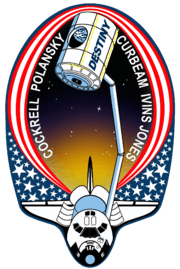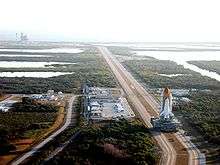STS-98
 Atlantis manoeuvres the Destiny module into position with its RMS | |||||
| Mission type | ISS assembly | ||||
|---|---|---|---|---|---|
| Operator | NASA | ||||
| COSPAR ID | 2001-006A | ||||
| SATCAT № | 26698 | ||||
| Mission duration | 12 days, 21 hours, 21 minutes, 0 seconds | ||||
| Distance travelled | 8,500,000 kilometers (5,300,000 mi) | ||||
| Orbits completed | 171 | ||||
| Spacecraft properties | |||||
| Spacecraft | Space Shuttle Atlantis | ||||
| Launch mass | 115,529 kilograms (254,698 lb) | ||||
| Landing mass | 90,225 kilograms (198,912 lb) | ||||
| Payload mass | 14,515 kilograms (32,000 lb) | ||||
| Crew | |||||
| Crew size | 5 | ||||
| Members |
Kenneth D. Cockrell Mark L. Polansky Robert L. Curbeam Marsha S. Ivins Thomas D. Jones | ||||
| Start of mission | |||||
| Launch date | 7 February 2001, 23:13 UTC | ||||
| Launch site | Kennedy LC-39A | ||||
| End of mission | |||||
| Landing date | 20 February 2001, 20:33 UTC | ||||
| Landing site | Edwards Runway 22 | ||||
| Orbital parameters | |||||
| Reference system | Geocentric | ||||
| Regime | Low Earth | ||||
| Perigee | 365 kilometers (197 nmi) | ||||
| Apogee | 378 kilometers (204 nmi) | ||||
| Inclination | 51.6 degrees | ||||
| Period | 92 minutes | ||||
| Docking with ISS | |||||
| Docking port |
PMA-3 (Unity nadir) | ||||
| Docking date | 9 February 2001, 16:51 UTC | ||||
| Undocking date | 16 February 2001, 14:05 UTC | ||||
| Time docked | 6 days, 21 hours, 14 minutes | ||||
  L-R: Robert Curbeam, Mark Polansky, Marsha Ivans, Kenneth Cockrell and Thomas Jones
| |||||
STS-98 was a 2001 Space Shuttle mission to the International Space Station (ISS) flown by Space Shuttle Atlantis. STS-98 delivered to the station the Destiny Laboratory Module. All mission objectives were completed and the shuttle reentered and landed safely at Edwards Air Force Base on 20 February 2001,[1][2] after twelve days in space, six of which were spent docked to the ISS.
Crew
| Position | Astronaut | |
|---|---|---|
| Commander | Kenneth D. Cockrell Fourth spaceflight | |
| Pilot | Mark L. Polansky First spaceflight | |
| Mission Specialist 1 | Robert L. Curbeam Second spaceflight | |
| Mission Specialist 2 | Marsha S. Ivins Fifth spaceflight | |
| Mission Specialist 3 | Thomas D. Jones Fourth and last spaceflight | |
Crew notes
Mark C. Lee was scheduled to fly as Mission Specialist 1 on his fifth trip to space, but due to undisclosed reasons, he was removed from this flight. His replacement was Robert Curbeam.
Launch attempts
| Attempt | Planned | Result | Turnaround | Reason | Decision point | Weather go (%) | Notes |
|---|---|---|---|---|---|---|---|
| 1 | 19 Jan 2001, 2:10:42 am | scrubbed | --- | technical | 15 Jan 2001, 3:00 pm | rollback to VAB for booster separation cable inspection[3] | |
| 2 | 7 Feb 2001, 6:11:16 pm | success | 19 days, 16 hours, 1 minute | 90% | [4] |
Mission highlights



The crew continued the task of building and enhancing the International Space Station by delivering the U.S. Destiny Laboratory Module. The Shuttle spent six days docked to the station while the laboratory was attached and three spacewalks were conducted to complete its assembly. The mission also saw the 100th spacewalk in U.S. spaceflight history. STS-98 occurred while the first station crew was aboard the new space station.
Space walks
| EVA | Spacewalkers | Start (UTC) | End | Duration |
|---|---|---|---|---|
| EVA 1 | Thomas D. Jones Robert L. Curbeam |
10 February 2001 15:50 |
10 February 2001 23:24 |
7 hours 34 minutes |
| Jones and Curbeam went to the payload bay of Atlantis where they disconnected cables and removed protective covers from the outside hatch of Destiny. Once at the installation site and after Destiny had been securely installed, the pair began connecting power and data cables. | ||||
| EVA 2 | Jones Curbeam |
12 February 2001 15:59 |
12 February 2001 22:49 |
6 hours 50 minutes |
| The pair of spacewalkers went outside and assisted the robot arm operator with removing the Pressurized Mating Adapter 2 (PMA-2) from the Z1 Truss segment and installing it onto the forward end of the Destiny laboratory. Once that task was complete Jones and Curbeam moved to a location on the Destiny lab and installed a Power Data and Grapple fixture and video signal converter, to be used with the Canadarm2. | ||||
| EVA 3 | Jones Curbeam |
14 February 2001 14:48 |
14 February 2001 20:13 |
5 hours 25 minutes |
| During the third and final spacewalk, the two spacewalkers attached a spare communications antenna to the International Space Station's exterior. They also double-checked connections between the Destiny lab and its docking port, released a cooling radiator on the station, inspected solar array connections at the top of the station and tested the ability of a spacewalker to carry an immobile crew member back to the shuttle airlock. | ||||
Wake-up calls
NASA began a tradition of playing music to astronauts during the Gemini program, which was first used to wake up a flight crew during Apollo 15.[5] Each track is specially chosen, often by their families, and usually has a special meaning to an individual member of the crew, or is applicable to their daily activities.[6][7]
| Flight Day | Song | Artist/Composer | Links |
|---|---|---|---|
| Day 2 | "Where You At" | Zoot Sims | [] |
| Day 3 | "Who Let The Dogs Out" | Baha Men | [] |
| Day 4 | "Girl's Breakdown" | Alison Brown | [] |
| Day 5 | "Blue Danube Waltz" | Johann Strauss Jr. | [] |
| Day 6 | "Fly Me to the Moon" | Frank Sinatra | [] |
| Day 7 | "For Those About to Rock" | AC/DC | [] |
| Day 8 | "To the Moon and Back" | Savage Garden | [] |
| Day 10 | "The Trail We Blaze" | Elton John | [] |
| Day 11 | "Blue (Da Ba Dee)" | Eiffel 65 | [] |
| Day 12 | "Fly Away" | Lenny Kravitz | [] |
| Day 14 | "Should I Stay or Should I Go" | The Clash | [] |
See also
- International Space Station
- List of human spaceflights
- List of International Space Station spacewalks
- List of Space Shuttle missions
- List of spacewalks and moonwalks 1965–1999
- Outline of space science
References
![]() This article incorporates public domain material from websites or documents of the National Aeronautics and Space Administration.
This article incorporates public domain material from websites or documents of the National Aeronautics and Space Administration.
- ↑ Jergler, Don. 2001. A textbook touchdown–Atlantis pays unexpected visit to desert. Antelope Valley Press (Lancaster/Palmdale, CA), 21 February 2001 issue, pp. A1, A5.
- ↑ Welcome Home. 2001. Desert Wings Vol. 53, No. 7, 23 February 2001 issue, p. 1.
- ↑ "NASA assesses booster wiring repair". CBS News. Retrieved 30 August 2009.
- ↑ "Shuttle count on track; good weather expected". CBS News. Retrieved 30 August 2009.
- ↑ Fries, Colin (25 June 2007), Chronology of Wakeup Calls (PDF), NASA, retrieved 13 August 2007
- ↑ Fries, Colin (25 June 2007). "Chronology of Wakeup Calls" (PDF). NASA. Retrieved 13 August 2007.
- ↑ NASA (11 May 2009). "STS-98 Wakeup Calls". NASA. Retrieved 31 July 2009.
